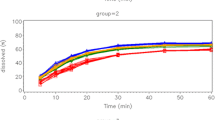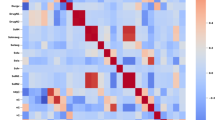Abstract
In this paper, the radial basis function-based Gaussian mixture model (GMM) is applied to model and predict drug dissolution profiles in a time-series approach. The Parzen-window method is embedded into the GMM for determining whether the network predictions are derived from interpolation or extrapolation of the training data. A benchmark study on time-series prediction is first used to evaluate and compare the GMM performance with those from other models. The GMM is then used to predict dissolution profiles of a matrix-controlled release theophylline pellet preparation. Performance of the GMM is assessed using the difference and similarity factors, as recommended by the United States Food and Drug Administration for dissolution profile comparison. In addition, bootstrapping is employed to estimate the confidence intervals of the network predictions. The experimental results are analyzed and compared, and implications of the GMM for pharmaceutical product formulation tasks are discussed.



Similar content being viewed by others
Explore related subjects
Discover the latest articles, news and stories from top researchers in related subjects.References
Wagner JG (1975) Fundamentals of clinical pharmacokinetics. Drug Intelligence Publications Inc., Hamilton
Ette EI, Howie CA, Kelman AW, Whiting B (1995) Experimental design and efficient parameter estimation in preclinical pharmacokinetic studies. Pharm Res 12:729–737
Obata Y, Li CJ, Fujikawa M, Takayama K, Sato H, Higashiyama K, Isowa K, Nagai T (2001) Evaluation and structure-activity relationship of synthesized cyclohexanol derivatives on percutaneous absorption of ketoprofen using artificial neural network. Int J Pharm 212:223–231
Nishizawa K, Hirano M, Yamamura S, Momose Y, Kimura A, Mochizuki T, Yamamoto Y (1998) Prediction of plasma levels of aminoglycoside antibiotic in patients with severe illness by means of an artificial neural network simulator. J Pharm & Pharm Sci 1:95–101
Brier ME, Aronoff GR (1996) Application of artificial neural networks to clinical pharmacology. Int J Clin Pharmacol Ther 34(11):510–514
Smith BP, Brier ME (1995) Empirical pharmacodynamic predictions using neural networks: comparison to NONMEM. Pharm Res 12(Suppl.):S328
Tolle KM, Chen H, Chow HH (2000) Estimating drug/plasma concentration levels by applying neural networks to pharmacokinetic data sets. Decis Support Syst 30:139–151
Hussain AS, Yu X, Johnson RD (1991) Application of neural computing in pharmaceutical product development. Pharm Res 8:1248–1252
Brier ME, Zurada JM, Aronoff GR (1995) Neural network predicted peak and trough gentamicin concentrations. Pharm Res 12:406–412
Takahara J, Takayama K, Nagai T (1997) Multi-objective simultaneous optimisation based on artificial neural network in sustained released formulations. J Contr Rel 49:11–20
Takahara J, Takayama K, Isowa K, Nagai T (1997) Multi-objective simultaneous optimisation based on artificial neural network in a ketoprofen hydrogel formula containing O-ethylmenthol as a percutaneous absorption enhancer. Int J Pharm 15:203–210
Bishop CM (1995) Neural network for pattern recognition. Clarendon Press, Oxford
Leonard JA, Kramer MA, Unger LH (1992) A neural network architecture that computes its own reliability. Comput Chem Eng 16:819–835
Efron, Tibshirani R (1993) An introduction to the Bootstrap. Chapman & Hall, London
Box GEP, Jenkins GM (1970) Times series analysis, forecasting and control. Holden Day, San Francisco
Sugeno M, Tanaka K (1991) Successive identification of a fuzzy model and its applications to prediction of a complex system. Fuzzy Sets Syst 42:315–334
Wang L, Langari R (1995) Building Sugeno-type models using fuzzy discretization and orthogonal parameter estimation techniques. IEEE Trans Fuzzy Syst 3:454–458
Kim E, Park M (1997) A new approach to fuzzy modelling. IEEE Trans Fuzzy Syst 5(3):328–337
Peh KK, Yuen KH (1995) Development and in vitro evaluation of a novel multi-particulate matrix controlled release formulation of theophylline. Drug Dev Ind Pharm 21:1545–1555
FDA guidance for industry: dissolution testing of immediate release solid oral dossage forms, August 1997
Goh WY, Lim CP, Peh KK (2003) Predicting drug dissolution profiles with an ensemble of boosted neural networks: a time-series approach. IEEE Trans on Neural Netw 14:459–463
Acknowledgements
The corresponding author gratefully acknowledges the research grants provided by University of Science Malaysia and the Ministry of Science, Technology, and Innovation Malaysia (No. 06-02-05-8002 & 04-02-05-0010) that have in part resulted in this article.
Author information
Authors and Affiliations
Corresponding author
Rights and permissions
About this article
Cite this article
Lim, C.P., Quek, S.S. & Peh, K.K. Application of the Gaussian mixture model to drug dissolution profiles prediction. Neural Comput & Applic 14, 345–352 (2005). https://doi.org/10.1007/s00521-005-0471-2
Received:
Accepted:
Published:
Issue Date:
DOI: https://doi.org/10.1007/s00521-005-0471-2




